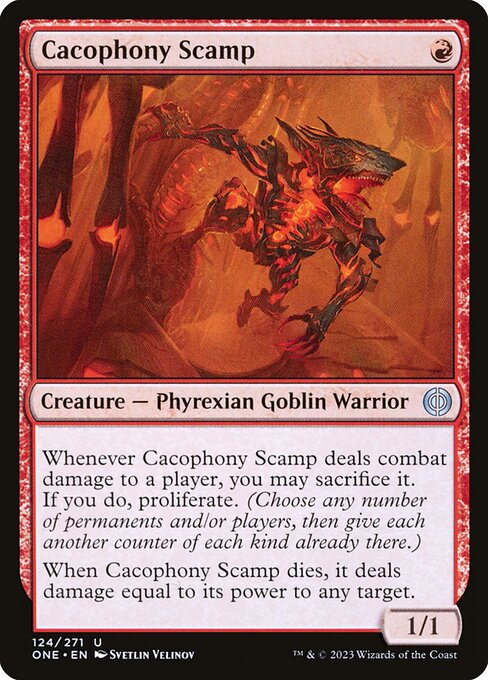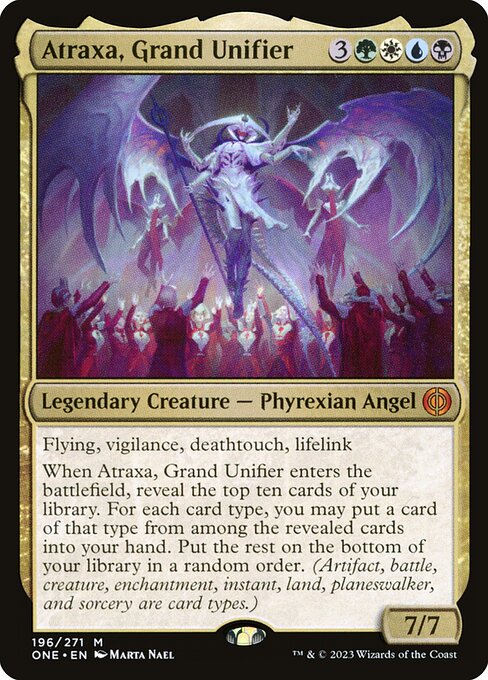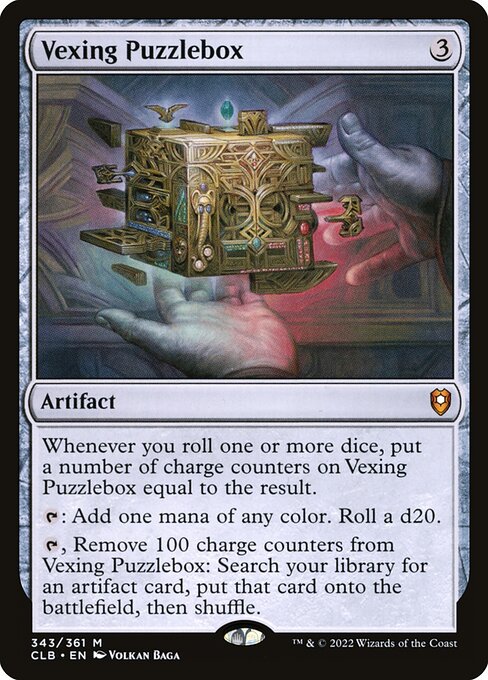The past year has been a fascinating one for Magic mechanics. Both Kamigawa: Neon Dynasty and Dominaria United were restrained in their use of new mechanics. Instead, they shone the spotlight firmly on returning mechanics like Sagas, Channel, Ninjutsu, Domain, and Kicker. This approach seems to continue in Phyrexia: All Will Be One. This set has more returning mechanics, and new mechanics which are twists on old ones, than any Premier expansion this side of Time Spiral Block. Today, we’re going to quickly go over all of these new mechanics, what they suggest about ONE Limited, and what they tell us about current Wizards’ design thinking.

Poisonous by Any Other Name Would Still Hurt as Much
Toxic is one of the major new mechanics in ONE, though it’s notably almost identical to how Poisonous worked in Future Sight and how poison creatures like Pit Scorpion worked way back in ‘93. The only difference with Poisonous is that it has no trigger, meaning a cleaner digital experience and slightly less upkeep in tabletop.
The design is simple and clean, where any amount of damage (be it a single point from a 1/1 Mite or a single point from a big Trample creature) yields the same amount of poison counters. Poison doesn’t do very much on its own (it just creates an alternate life total), but in conjunction with abilities like Corrupt and Proliferate, getting any poison counters at all is mechanically relevant and will feel absolutely distinct from normal damage.
Toxic is almost certainly a major upgrade in Limited to Infect (though it’ll almost certainly be weaker in Constructed). In Scars of Mirrodin Limited (the first Limited format I played at all seriously), decks needed to commit completely to having all-Infect creatures or none. Mixing and matching essentially let your opponent start the game at 30 life, since your Infect creatures always dealt 0 damage to life and your non-Infect creatures never advanced your poison win condition. Toxic ensures that all of your combat damage is always relevant, since even if you fall short on poisoning your opponent to death, their life total will have been falling at the same time. That should make for far more interesting gameplay and flexible draft plans.

Under the Influence
Corrupted is a new ability word which upgrades your cards once an opponent has three or more poison counters. We’ve actually seen this kind of Threshold mechanic on cards like Chained Throatseeker and the aptly-named Corrupted Resolve, though there the Threshold was any amount of poison.
This seems like a great mechanic to encourage both all-in poison decks that’re aiming to get your opponent to 10 poison, and hybrid decks that will probably kill with damage while inflicting poison along the way. As with Toxic, this alleviates the all-or-nothing gameplay of Infect from Scars of Mirrodin block by rewarding you for getting partially to 10.
The number 3 seems like a solid choice. If cards upgraded once a player simply had any poison (as was the case with SOM’s few cards), then there’s an immediate and ultimately less interesting tension—you need to block every toxic creature. Once you get that first point of poison, the tension dissipates, since there’s no milestone between 1 and 10. With 3, you can afford to take a hit or two. Sure, they might be able to Proliferate up to 3, but that’s a risk you can choose to take rather than a certainty.

Charging Up
Our third new mechanic is oil counters. Thematically, it makes great sense for glistening oil to be featured in a set defined by a triumphant Phyrexia covered in the stuff. Mechanically, it works well for the Phyrexians to accumulate this valuable currency and utilize it to obtain power over others.
Until a few years ago, Magic had hard rules about not having more than one type of counter commonly go on creatures (and it was almost always +1/+1 counters). It’s just too hard to keep track of different types of counters or states when all you’ve got are dice or coins. That’s why we’ve gotten punch-out counters in Amonkhet, Ikora: Lair of Behemoths, and Brothers’ War. Here, oil counters are used in such a high volume that they replace +1/+1 counters entirely.
Normally, I’d be worried that a counter is being used in so many different ways—charge counters, +1/+1 counters, even time counters for Vanishing! But with it both getting the spotlight and having no competing counters (and it mostly performing familiar tasks), it might not be too overwhelming keeping track of this flexible resource.
Rebel Yells

For Mirrodin! Is another twist on Living Weapon, a mechanic that has spawned many designs. Over the past several years, we’ve seen plenty of equipment that comes with a creature (Ancestral Blade, Giant’s Amulet, Barbed Spike, and more) as well as new ways to circumvent that first equip cost (the snap-on equipment of Zendikar Rising based on Grifter’s Blade).
Here, you’re getting a 2/2 Rebel instead of a 0/0 Germ. That changes the design space significantly. Every Living Weapon had to provide at least some toughness boost so the Germ didn’t die immediately. Here, you can get away with only providing power boosts, or keywords, or even a weird ability like Blade of Shared Souls. That said, coming with a 2/2 applies different restrictions—the bonus either needs to be smaller than the average Living Weapon’s, or the card is going to cost a lot more.
The mechanic’s plane-specific (and frankly silly) name suggests that there’s not much design space here. I don’t find it terribly exciting, since we’ve seen plenty of cards like this, and having an equipment subtheme tends to encourage very linear, fragile archetypes based around equipment and equipped creatures. I’m also a bit confused why the Mirrans’s sole mechanic is a repurposed Phyrexian mechanic.
Those are more personal preferences than substantive critique, but the mechanic doesn’t seem to be doing anything especially novel. I’d be kinder to For Mirrodin! if it weren’t one of five mechanics (most of which are tweaks on familiar mechanics) and alongside several returning mechanics. It reminds me of Crimson Vow and Midnight Hunt, where Cleave and Investigate felt like they should have been saved for a set that had room for them.
Dante’s Inferno

This is a mini-mechanic, so we won’t spend much time on it, but ONE introduces a new nonbasic land type in Spheres. There are presumably nine, one for each layer of New Phyrexia. This also serves as a callback to the original Phyrexia, which itself was referencing Dante’s Inferno. At time of writing, they seem like a gentle mini-theme like gates were in Return to Ravnica block. They add a little bit of complexity while mostly serving to add some texture to Limited and Constructed. It also doesn’t hurt to add flavor to the world. That seems perfectly good.
…And All The Rest

There are a host of returning mechanics.
Proliferate seems to be a significant player in All Will Be One. It’s a fantastic mechanic which requires a lot of support to function. It interacts really well with Toxic and oil counters, plus it’s one of the big Phyrexian mechanics from Scars of Mirrodin block. It makes a lot of sense here.
Battle Cry is making a return after its birth in Mirrodin Besieged back in 2011 (and a couple one-off appearances in Modern Horizons 1, Unstable, Unfinity, and Warhammer 40K). It’s a fine go-wide, aggressive combat mechanic.
Phyrexian mana is returning, though it’s only on activated abilities and Planeswalkers. It’s one of the most broken mechanics in Magic, though that likely has more to do with its execution (undermining the color pie by making colored effects very cheap and colorless) than the core concept. Only having it on cards that require spending colored mana should hopefully make it play much better.
With Phyrexian mana comes Compleated planeswalkers. How they work has slightly changed functionality thanks to Nissa, Ascended Animist, the first Compleated planeswalker with multiple Phyrexian mana symbols. It’s the kind of mechanical expansion which could be absolutely fine, or confusing in how the new design space is only spelled out in reminder text.
Affinity is back, too! Yep, another one of the most powerful mechanics in Magic is back in this set. At time of writing, it’s only on Oxidda Finisher, and affinity is only at its most busted when it’s for a card type like artifacts which are easy to flood the board with. Something more specific like equipment is much harder to break (especially when it doesn’t go on many lands).
Finally, there’s Flashback, which has become deciduous. That makes sense given its ubiquity, popularity, and massive design space. But while that’s a (hopefully) complete listing of every mechanic in ONE, we’ve still got one last thing to quickly cover.

There’s a call forward to the mysterious new card type, Battle. This almost certainly will be a feature mechanic in the next expansion, March of the Machine. I wouldn’t be surprised if it’s the first printed iteration of the Skirmish concept from War of the Spark (which may have drawn inspiration from Ixalan’s exploratory design that led to the creation of the Monarch), but at present we can only guess at its functionality. It’s the rare example of a throw-forward, where a card references something exclusive to the future (which some players will find incredibly exciting). I find it a bit notable to do so this close to Karn, Living Legacy, though Karn wasn’t technically a throw forward, since Karn actually employed Powerstones rather than hinted at their function. But with that, we’re done!

Putting Alllll the Pieces Together
There is… so much going on in this set. There’s a decent chance that the multitudinous mechanics mesh and keep onboard complexity down. Toxic is only relevant during combat. Corrupted is a simple threshold mechanic that never turns off. For Mirrodin! is an enters-the-battlefield effect. Oil Counters replace +1/+1 counters (and so are the only major counter being tracked). Spheres are a mini-mechanic.
That’s a lot to keep track of, but each mechanic only does so much and creates minimal on-board complexity (except for Oil Counters, but again, taking away +1/+1 gives them a lot of room). Still, that’s a fair number of mechanics, each of which adds its own cognitive load… not to mention the load presented by the six returning mechanics.
Online, this shouldn’t too big an issue, since the computer executes all these game actions for you. But in tabletop, each mechanic, no matter how simple, adds some cognitive load. Each gives you something to remember, a new game action to perform, and another variable to apply to your opponent. Just like how it can be harder to balance ten small objects on a plate than two or three heavy objects, many small complications can combine to create a bigger mental load than a couple complicated mechanics. I’m a bit concerned that the popularity of Commander is being used to justify oversaturating Limited sets. Direct-to-Commander products like accompanying Commander decks and Set Booster exclusives (which sometimes are also Standard-legal) allow those mechanics to be spotlit without going through Limited.
Perhaps I’m just an old man yelling at a cloud. Perhaps current players don’t struggle with wordy cards in wordy sets with a dozen mechanics. But I wouldn’t be surprised if Limited is heading to a tipping point where the digital experience sings while the tabletop experience buckles under heavy cognitive loads. I don’t know, but I do know that the sheer amount of stuff in ONE makes me apprehensive. My hope is that the end product is one harmonious experience where all the fat has been trimmed, rather than a plethora of ideas stitched together. But perhaps that’s the point, since that’s exactly what New Phyrexia itself is.
Zachary Barash (he/him) is a New York City-based game designer and the last commissioner of Team Draft League. He designs for Kingdom Death: Monster, has a Game Design MFA from the NYU Game Center, and does freelance game design. When the stars align, he streams Magic (but the stars align way less often than he’d like).

